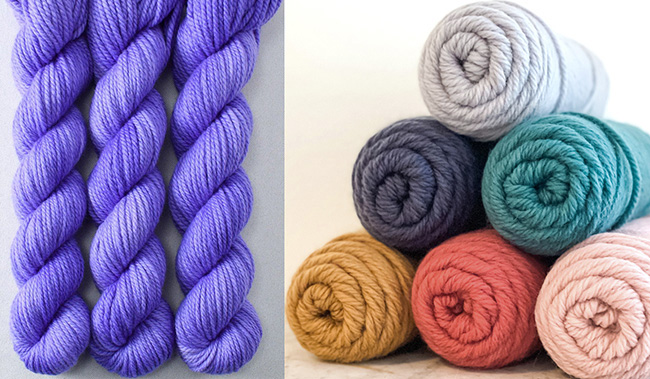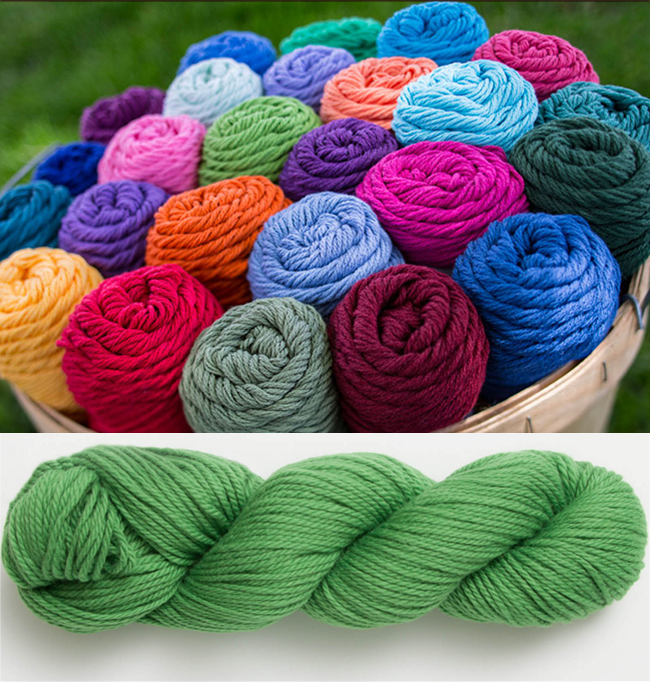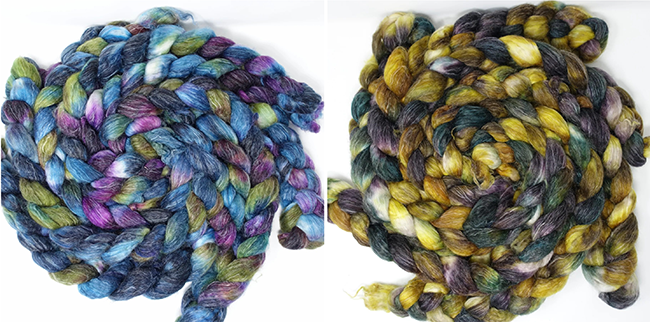Substitution Solutions, a column where a spinner uses her knowledge of fiber, yarn construction and knitting to substitute yarns by Jillian Moreno
INTRODUCTION
Substitution Solutions
How to substitute yarn in a pattern
It’s so important for a knitter to feel comfortable substituting a yarn. More and more designers are offering substitution ideas in their patterns, or at least a description of the type of yarn to look for when choosing a substitute, and you'll find helpful descriptors of Yarn Characteristics in every Knitty pattern starting with Winter 2021.
In this column, I walk you through substituting yarn for a couple of patterns in the current issue. There is absolutely nothing wrong with the great yarns that our designers have chosen for their projects. I’m just giving my opinion on other yarns to use, based on how I – as a spinner – look at a yarn and a pattern, making choices based on what I know about fiber, yarn construction, and knitting. Even if the recommended substitution yarns are discontinued one day, my hope is that the information below will make the process of choosing an alternate yarn less daunting, and help you knit projects that give you joy in the knitting and wearing.
Warm Weather Knitting
This issue, we’re looking at two patterns perfect for warm-weather knititng. One is a chunky yarn knit. I love to knit with chunky yarns in warm weather because they go so fast! Substituting chunky yarns can be tricky at times because of wanting a not-too-heavy yarn with a yarn that has some durability.
The other is a summer sweater that combines cotton and wool. Getting the right balance between the two fibers is important, as is the right amount of plies and twist. I never want a summer sweater that is waist length in the morning and creeps toward my knees by the afternoon.
Frosty Musings

Frosty Musings by Amy Odin
Description of the project:
Frosty Musings is a chunky shawl with simple but interesting patterning, a little texture, a little lace. A quick knit and a perfect shawl for summer nights or overly air conditioned spaces.
What is important about this design:
This shawl has both texture and lace, a choice needs to be made which one to emphasize. Softness is key for this since it may get wrapped around your neck. As with any shawl, a little drape is nice.
What elements of yarn construction should we think about?:
Fiber is key for softness. Merino is always good, but tends to pill, and many other not-as-soft yarns are still neck-wearing soft. The number of plies is what will either emphasize lace (2-ply) or texture (3-ply +).
Substitution Solution:
The yarn I’d use for this is Kelbourne Woolens Germantown Bulky. This would give a little more durability with the fiber. It’s not Merino soft, but it’s soft enough for my neck. It won’t pill, even after repeatedly stuffing the shawl into my going-to-the-lake bag. I’m opting to show off the texture rather than the lace and this 4-ply yarn will do just that.

L: Frosty Musings original yarn: Miss Babs K2
R: Substitution Solution: Kelbourne Woolens Germantown Bulky
Yarn Specified in the pattern:
Name: Miss Babs K2
Fiber: 100% Merino
Type of Spin: Worsted
Ply: 3
Length/ Weight: 120 yd / 4 oz (110m / 113g)
Ballband Gauge: 12-14 stitches = 4 inches/ 10 cm in stockinette stitch
Pattern Gauge: 13 sts / 16 rows = 4 inches/ 10 cm in stockinette stitch
Suggested replacement yarn:
Name: Kelbourne Woolens Germantown Bulky
Fiber: 100% N. American Wool
Type of Spin: worsted
Ply: 4
Length/ Weight: 123 yards (112 meters) / 100 gram skein
Ballband Gauge: 11-13 sts = 4 inches/ 10 cm in stockinette stitch
Spinning Solution:
My choice to spin for this project is Neighborhood Fiber Company Cobblestone Roving. The BFL/silk combo will make a yarn that is durable, with a softer stitch definition, and with great drape.
Fiber of choice:
Name: Neighborhood Fiber Company Cobblestone Roving
Fiber: 75% Bluefaced Leicester, 25% Silk

How I would spin it: Many spinners would spin this into finer singles and ply up to size, but I want to spin this as a fat single, with a bit of loft.
I would set up my wheel that I can treadle the slowest with its biggest whorl, so I can work with low twist. I would spin it worsted with control. For me that means no sweeping long draw. I would finish it with a bit of fulling to stabilize the single just a bit, moving the yarn from hot to cold water a few times.
![]()
Pentwater

Pentwater by Renee Kulling
Description of the project:
Pentwater is my sweater crush of this issue, the shape the structure, the stitch patterns, it’s all so good. The designer describes it really well, “Pentwater is exactly the kind of pullover I want to wear after a summer day outside, when the sun is setting and a slight chill is falling on my fresh sunburn”. Yes, please.
What is important about this sweater:
Finding a yarn that will hold structure and shape with almost all over lace patterning is the most important to me. I don’t want this sweater to drape or droop!
What elements of yarn construction should we think about?
The combination of wool and cotton is a good one for structure. A 2-ply or a less tightly twisted 3-ply would work for lace with structure. I wouldn’t use a yarn that gives soft stitch definition, unless you’d like a more drapey sweater. If that’s the case a blown yarn would be interesting.
Substitution Solution:
I would knit this sweater in Blue Sky Fibers Sweater Worsted. I like the heavier wool content for a little more elasticity, the 2-ply structure for more open lace, and the addition of superwash, so I can throw it in the washing machine. It also comes in a great range of colors.

Top: Pentwater original yarn: Brown Sheep Cotton Fleece
Bottom: Substitution Solution: Blue Sky Fibers Sweater Worsted
Yarn Specified in the pattern:
Name: Brown Sheep Cotton Fleece
Fiber: 80% pima cotton, 20% merino wool
Type of Spin: worsted
Ply: 3+ tight twist
Length/ Weight: 215yd/197m per 100g skein
Ballband Gauge: 20 stitches = 4 inches in stockinette
Suggested replacement yarn:
Name: Blue Sky Fiber Sweater Worsted
Fiber: 55% Superwash Wool / 45% Certified Organic Cotton
Type of Spin: worsted
Ply: 2
Length/ Weight: 100g / 160yds
Ballband Gauge: 16-20 stitches = 4 inches
Spinning Solution:
I’d like to spin for this with some colorful fiber in a really interesting blend. Hilltop Cloud does wools blended with ramie rather than flax/linen. Ramie is made from nettles which gives structure like flax/linen, but I find it to be a little softer and not as poke-y
Fiber of choice:
Name: Hilltop Cloud
Fiber: 75% Superwash British BFL/ 25% Ramie

How I would spin it:
I would spin a 2-ply yarn with maybe a bit of extra ply twist. I would need to sample to see if the extra twist makes the yarn too heavy. I'd spin it with a worsted draft to keep the yarn smooth, do something to add a little air to the combed top preparation. I would either spin it from the fold or steam it before I spin. As for the colors, I chose two and will keep them mostly separate but may blend them for some of the transitions. More sampling!
![]()
ABOUT THE AUTHOR
 Jillian Moreno is Knitty's Catalyst and Spinning editor. She's the Developmental Editor for PLY Magazine and PLY Books. A couple years ago, she wrote the best-selling spinning bookYarnitecture: A Knitter’s Guide to Spinning: Building Exactly the Yarn You Want. Now she’s writing another spinning book and trying hard not to start weaving.
Jillian Moreno is Knitty's Catalyst and Spinning editor. She's the Developmental Editor for PLY Magazine and PLY Books. A couple years ago, she wrote the best-selling spinning bookYarnitecture: A Knitter’s Guide to Spinning: Building Exactly the Yarn You Want. Now she’s writing another spinning book and trying hard not to start weaving.
She lives in a house packed with fiber and books and has a hand-spinning Patreon over here.
Frosty Musings image © Amy Odin; Pentwater image © Renee Kulling; all other images courtesy the yarn and fiber dyers as listed with the image. Contact Jillian







